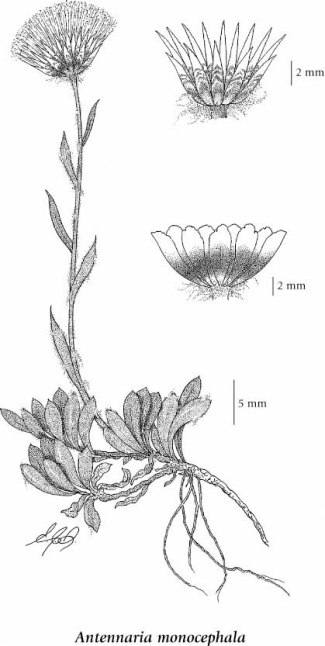Antennaria monocephala DC.
one-headed pussytoes (pygmy pussytoes)
Asteraceae (Aster family)
Introduction to Vascular Plants
one-headed pussytoes (pygmy pussytoes)
Asteraceae (Aster family)
Introduction to Vascular Plants
Species Information click to expand contents
General:
Perennial herb, mat-forming with stolons 2-4.5 cm long; stems erect, few, simple, glandular, 2-16 cm tall.
Leaves:
Basal leaves spoon-shaped to oblanceolate, gradually stalked, 5-20 mm long, 2-5 mm wide, grey woolly-hairy to glabrate below, usually green glabrous or glabrescent above, 1-nerved; stem leaves similar, becoming unstalked, linear, reduced upwards with prominent papery tips.
Flowers:
Heads solitary (rarely 2-3), terminal; involucres of 2 types, the female ones 4-8 mm tall with hairy bases, the male ones similar, 3.5-7 mm tall; involucral bracts lanceolate, the upper papery portion brown, dark brown, black or olivaceous; female flowers 3.5-4.0 mm long, male flowers 2.5-3.5 mm long.
Fruits:
Female achenes 1-1.4 mm long, usually glabrous, the pappus white with hairlike bristles, 4-5 mm long; male pappus hairs club-shaped and toothed at the the tips, 2.5-3.5 mm long.
Notes:
Two subspecies have recently been recognized for YT (Bayer 1996). Both taxa are also found in BC but often are indistinguishable in herbaria material since separation depends mainly on the presence or absence of male flowers. Female and male plants are equally common in populations of the ssp. monocephala while male plants are lacking in the strictly northern ssp. angustata. The collecter should make a note of this feature in the field if the separation recognized by Bayer and Stebbins (1993) is desired. Only the ssp. monocephala may sometimes be verified in the herbaria.
Illustration click to expand contents

If more than one illustration is available for a species (e.g., separate illustrations were provided for two subspecies) then links to the separate images will be provided below. Note that individual subspecies or varietal illustrations are not always available.
Illustration Source: The Illustrated Flora of British Columbia
Ecology click to expand contents
Ecological Framework for Antennaria monocephala
The table below shows the species-specific information calculated from
original data (BEC database) provided by the BC Ministry of Forests and Range.
(Updated August, 2013)
The table below shows the species-specific information calculated from
original data (BEC database) provided by the BC Ministry of Forests and Range.
(Updated August, 2013)
| Site Information |
Value / Class |
||
|
Avg |
Min |
Max |
|
| Elevation
(metres) |
1741 | 14 | 2430 |
| Slope
Gradient (%) |
15 | 0 | 85 |
|
Aspect (degrees) |
146 | 0 | 360 |
| Soil
Moisture Regime (SMR) [0 - very xeric; 4 - mesic; 8 - hydric] |
3 | 0 | 8 |
| Modal
Nutrient Regime
Class |
C | ||
| #
of field plots species was recorded in: |
274 | ||
| Modal
BEC Zone Class |
BAFA | ||
|
All BEC Zones (# of stations/zone) species was recorded in |
AT(1), BAFA(232), BWBS(1), cma(1), ESSF(9), IMA(12), SWB(14) | ||
|
Source:
Klinkenberg 2013
|
|||
Habitat and Range click to expand contents
Moist to mesic meadows and snowbed sites in the subalpine and alpine zones; common in N BC, infrequent in E BC; amphiberingian, N to AK, YT and NT and E to NF; E Asia.